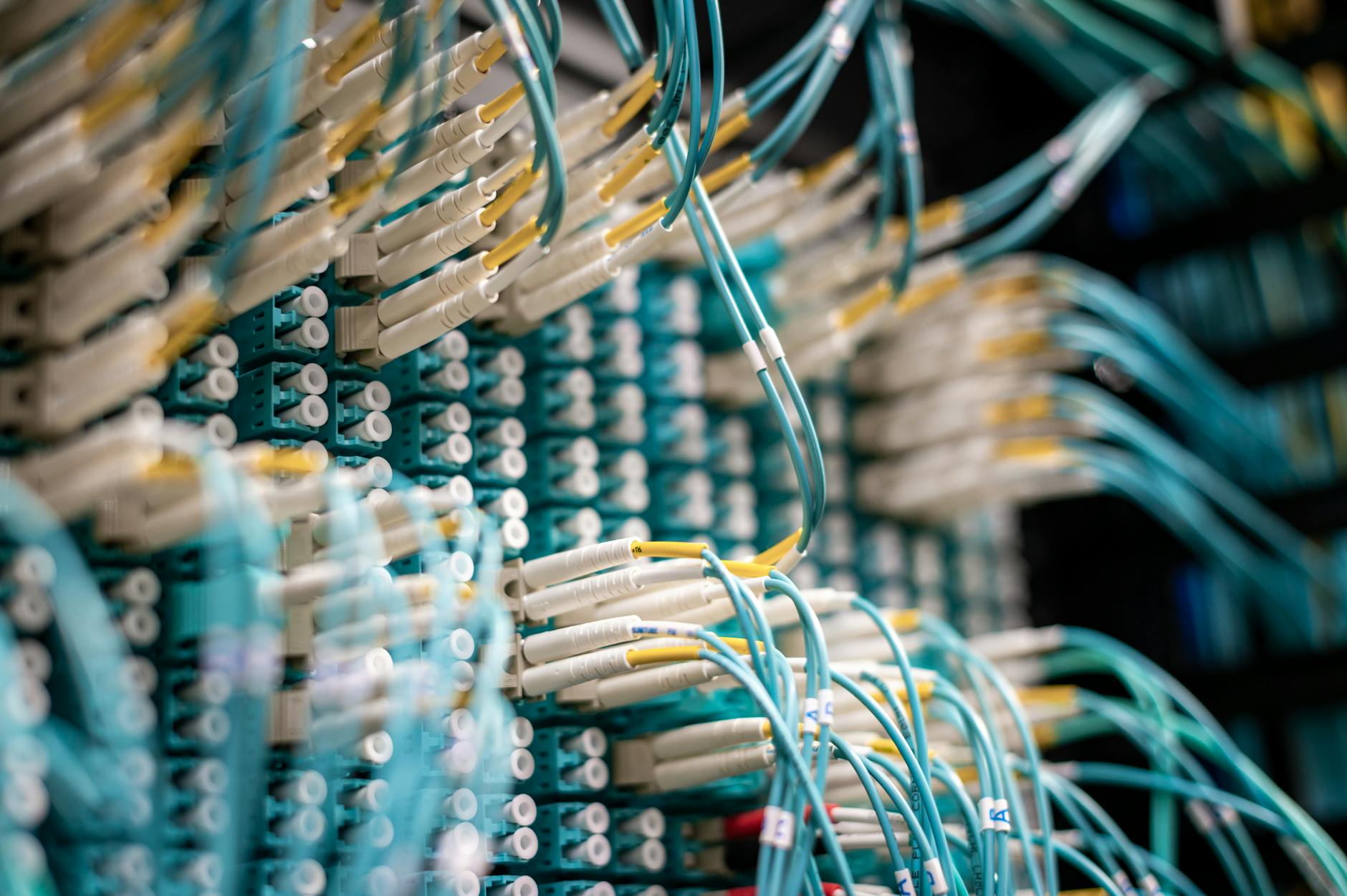Cost-Benefit of Fiber Optics in Telecommunications
Transmission Methods Overview
To get a grip on the cost and benefits of fiber optics in telecom, it’s important to know how different methods of getting data from A to B stack up. This section looks at the popular ways to make that happen: fiber optics, microwave tech, satellite, and 5G.
Fiber Optics Advantages
Fiber optics are the big thing in telecom because they come with plenty of perks:
- High-Speed Data Transmission: We’re talking bandwidths that can hit speeds over 10 gigabits per strand (Antaira).
- Resistance to Interference: They don’t get rattled by electromagnetic interference or rust, keeping connections crisp and errors low (Field Nation).
- Wide Range of Applications: Businesses and governments love optical fibers for everything from data moving to secure chats (UFINET).
- Global Connectivity: They’re the backbone of high-speed internet, crucial for quick data transfer all over the place (UFINET).
Microwave Technology Overview
Microwave tech is another way to keep the data flowing, especially between two points:
- High-Frequency Signals: It uses signals that bounce around from 1 GHz to 300 GHz.
- Line-of-Sight Requirement: Needs a clear path between antennas, which can be a bummer in some areas.
- Speed and Reliability: Can zip data around fast and is pretty reliable, but weather and obstacles might mess things up.
Dig deeper into microwave tech with our piece on microwave transmission advantages and disadvantages.
Space Transmission Insights
Space transmission sends data through satellites:
- Coverage: Perfect for out in the sticks where nothing else works.
- Latency: The catch? It can be slow due to faraway signals.
- Cost: Rocketing a satellite into space ain’t cheap, but useful on a grand scale.
Tackle more on this in challenges of space transmission for telecommunication.
Exploring 5G Connectivity
5G is the new kid on the block in mobile telecom:
- High-Speed Data: It’s blazing fast, going up to 10 Gbps, beating older versions by miles.
- Low Latency: Super low delay means cool stuff like VR and self-driving cars are not just a dream.
- High Capacity: Can handle more devices, perfect for anything IoT.
| Transmission Method | Speed | Coverage | Latency | Cost |
|---|---|---|---|---|
| Fiber Optics | >10 Gbps | Broad | Low | $60,000-$80,000/mile (Dgtl Infra) |
| Microwave | High | Limited | Moderate | Moderate |
| Space | Moderate | Extensive | High | High |
| 5G | Up to 10 Gbps | Urban | Very Low | High |
For a side-by-side on fiber optics vs. 5G, swing by our article on technological comparison of fiber optics and 5g transmission.
Grasping these methods is key if you want to make smart choices in telecom tech and what they mean for your budget. Check out detailed sections on microwave transmission, space transmission, and 5G connectivity for the full scoop.
Pros and Cons of Fiber Optics
Let’s slice into the nitty-gritty of fiber optics and see their worth in the tech scene today. We’ll check out why these glass wires rock and where they might trip up.
Benefits of Fiber Optics
Fiber optics have quite the laundry list of positives that make them a great pick for telecom stuff:
-
High Speed and Huge Capacity: Fiber optics can move data faster than your morning coffee runs out. These cables leave the old copper ones eating dust, handling all your HD video calls and massive file transfers like a breeze.
-
Room to Grow: They easily stretch to let businesses keep up with more and more data needs. So, as your biz gets bigger, the cables can keep up without needing a major overhaul. It’s like adding a new room to your house instead of moving altogether.
-
Security Fort Knox Style: Fiber cables don’t broadcast signals, so nosy parkers can’t eavesdrop easily. If something shady does happen, it’s easier to catch it in the act, thanks to central hardware keeping things in check.
-
Signal Blocking Superpower: They laugh in the face of interference from other gizmos. In places loaded with machines, fiber keeps everything running smoothly, dodging data loss and pesky delays.
Limitations of Fiber Optics
Fiber optics aren’t all sunshine and rainbows, though. Here are some hiccups:
-
Pricey Start-up: Getting these snazzy cables up and running can burn a hole in your wallet. The gear, the setup, the works – it all adds up, which might be a hurdle for some businesses to jump over.
-
Time-Consuming Installations: Getting them in place can be a slow grind. Depending on how far you’re spreading the network, it could take up to 10 months before everything’s good to go.
-
Handle With Care: These cables are a bit on the delicate side, more so than their copper cousins. Easy breaks mean extra caution during setup.
-
Not Everywhere Just Yet: While cities are spoiled with fiber, folks out in the boonies might not have as much luck. The network’s reach can be a bit patchy outside urban sprawls, which could clip its wings a bit in some parts.
Getting a handle on both the good and not-so-good sides of fiber optics will help decide if they’re the future we need. For comparisons galore, see how it stacks up against microwave transmission and the whole 5G vs. microwave debate.
Cost Analysis of Transmission Methods
Checking out the costs and perks of various ways to send data in telecommunications helps make the smart choices. Here you’ll see how fiber optics, microwave, space, and 5G stack up financially.
Financial Comparison
Each transmission method—fiber optics, microwave, space, and 5G—comes with its own price tag. The upfront costs, day-to-day expenses, and eventual money-back can differ quite a bit between them.
| Transmission Method | Starting Costs | Running Costs | Long Haul Perks | Hurdles |
|---|---|---|---|---|
| Fiber Optics | High | Low | Fewer hiccups, rare downtimes | Steep to set up |
| Microwave | Medium | Medium | Easy to set up | Weather-prone, must-see distances |
| Space Transmission | Really High | High | Reach everywhere | Delays and costly setup |
| 5G | High | Medium | Fast data, little delay | Limits in area and gear |
Budget Thoughts
When figuring out the money side for each method, think about not just the beginning costs but also how much keeps piling up over time.
Fiber Optics
Getting fiber optics rolling costs a pretty penny, especially if you’re covering all bases. Hooking up about 16 million households without good service in the U.S. could hit $200 billion or more. Even with that hefty bill at the start, the payoff in the long run is sweet with few operation interruptions and barely any downtime. Those pros lead to saving money overall, making fiber a solid choice for businesses thinking ahead.
Getting all homes connected means dealing with different landscapes, varying population densities, and changing rules. Trying a one-way-for-all answer could have its downsides, so we must stay flexible to address geographical and demographic differences.
Microwave Technology
Microwave tech starts out cheaper than fiber optics and doesn’t ask a ton for upkeep. Its adaptability makes it great for tough terrains or in spots needing quick setup. Still, mind its issues: it needs a clear path and can get moody with the weather.
Space Transmission
Space transmission sends the bill soaring, mostly due to launching and keeping satellites up there. Its global reach is unbeatable, but big delays and high setup costs can be real sticking points.
5G Connectivity
5G takes a good chunk of change to get going and runs at medium upkeep cost-wise. It’s a win for cities where speed and low delay are top priorities. Just keep in mind the coverage might hit snags, especially in out-of-the-way places.
Knowing the money game and budget quirks of each option helps sharpen up plans and choices in the telecom sector.
Application in Worldwide Connectivity
Impact on Global Communication
Fiber optics have totally changed how we chat, text, or face-time. Imagine sending data as fast as a race car zooms past! These networks are the magic behind high-speed internet, helping you share and grab info wherever you are, be it for school, doctors, or making those business deals (UFINET). It’s made a big splash across tons of areas like schools and hospitals.
With the power to dish out high-speed internet, students now enjoy online classes, Newton-style (just not under an apple tree), while the medical world gets to play doctor through screens with telemedicine (UFINET). It’s all about being connected without moving around too much.
Global Communication Networks Table
| Transmission Method | Speed | Reliability | Average Cost per Mile | Applications |
|---|---|---|---|---|
| Fiber Optics | Up to 100 Gbps | High | $60,000 – $80,000 | Internet, Schools, Health |
| Microwave | Up to 1 Gbps | Medium | Varies | Countryside setups, Direct links |
| Satellite | Up to 500 Mbps | Medium | High | Out in the sticks, Worldwide access |
| 5G Tech | Up to 10 Gbps | High | Varies | Smartphones, Smart cities |
Telecommunication Evolution
Telecom as we know it got a massive lift thanks to fiber optics. Those old-school copper wires and microwaves? They can’t keep up with the fiber optics’ lightning-fast speed and trustworthiness (UFINET).
Fiber optics hype up industries by setting up sturdy networks that don’t play hot potato with your data. These nifty lines keep things ticking, ensuring people anywhere get connected. Even out in the boonies, fiber optics are finally making tech accessible.
Sure, setting up those networks doesn’t come cheap. Getting one done costs about $1,000 to $1,250 for each house passed or $60,000 to $80,000 per mile (Dgtl Infra). Pricey? Yes, but the benefits and dependability down the line make it the go-to pick in today’s world.
Evolution and Cost Table
| Evolution Stage | Primary Technology | Average Speed | Average Cost (Per Mile/Household) |
|---|---|---|---|
| Old School | Copper Wires | Up to 56 Kbps | Affordable |
| Microwave Moves | Microwave | Up to 1 Gbps | Varies |
| Fiber Optics Era | Fiber Optics | Up to 100 Gbps | $60K – $80K / $1K – $1.25K |
| Cutting Edge | 5G, Fiber Optics | Up to 10 Gbps | Varies |
To scope out what works and what doesn’t, check out our snippets on microwave transmission pros and cons and 5G vs microwave tech smackdown.
Fiber optics haven’t just boosted global chit-chat; they’ve redefined what’s possible in telecom. They’re like this ultra-reliable highway for data, paving the way for cool breakthroughs and closing the communication gap all around the globe.
Future Trends in Telecommunication
Getting familiar with future trends in telecommunication helps you understand how we’re all getting more connected globally. Let’s check out what’s happening with cool tech and where the industry seems to be heading.
Technological Advancements
If telecommunication feels like it’s always changing, that’s because it is. There’s always some new tech on the block that’s making our chats, data, and video zoom around faster and more reliably.
Fiber Optics
Fiber optics? Oh, they’re the big guns in making sure your Internet is as fast as your favorite hotrod. These glass threads let us send stuff like voice, data, and videos super far without a hitch, setting up broadband that keeps our world joined together (UFINET). Basically, they’re the invisible highways of your super speedy internet.
| What’s Hot | Fiber Optics |
|---|---|
| Zoom (Speed) | Ultra-speedy |
| Trusty | Super-reliable |
| Whoa (Distance) | Cross-country |
Want to nerd out more about how fiber optics stack up against other tech? Dive into our gritty details on comparing fiber optics and 5G.
5G Connectivity
5G is like the rocket fuel for your phone—it’s all about faster downloads, barely there delays, and talking to a zillion gadgets at once. The must-have for IoT (Internet of Things), making everything from your toaster to your car just a bit smarter.
| What’s Cool | 5G Connectivity |
|---|---|
| Magic (Speed) | Rocket fast |
| Ninja (Latency) | Minimal |
| Party (Device Support) | Crowd-friendly |
Get down to the nitty-gritty of 5G vs the retro charm of microwave tech in our comparison article here.
Microwave and Space Transmission
Microwave tech is the go-to for medium hops, especially where laying cable is a no-go. Meanwhile, satellites have our backs in those lone ranger places, beaming out TV, radio, and net access far and wide.
See the ups and downs of microwave tech here and get the lowdown on space transmission trouble at this link.
Industry Growth Outlook
The telecom universe is all geared up for a growth spurt, thanks to non-stop tech leaps and folks consistently craving more global connectivity. Here’s what’s cooking in the growth department.
Expansion of Broadband Networks
With more peeps and businesses demanding their internet fix, putting cash into fiber optics is a no-brainer. Places everywhere are looking to get their wires crossed in the best way possible, boosting their digital hustle. Fiber optics make sure even those tucked away neighborhoods can stream the latest cat video without buffering (UFINET).
Growth in IoT and Smart Cities
As IoT gadgets and smart city tech spring up, demanding networks that can handle hunks of data and stacks of sensors become vital. Fiber and 5G are our trusty companions on this adventure.
Rising Demand for Streaming and Remote Work
Netflix and Zoom: two things we can’t imagine life without anymore. The recent trend upped the call for top-notch streaming and remote working setups, making telecom uptick to manage heavy-duty data flows smoothly.
| What’s Fueling Growth | Impact on the Biz |
|---|---|
| Broadband Internet | Like, Huge |
| IoT & Smartness | Seriously Big |
| Streams & Remote Gigs | Must Have |
As we keep cruising along, telecommunication keeps pulling out the best it has in fiber optics, 5G, and the rest to make sure our chats, binges, and work keep ticking along without a glitch.
Need more? Skim through our piece on fiber optics vs 5G.













